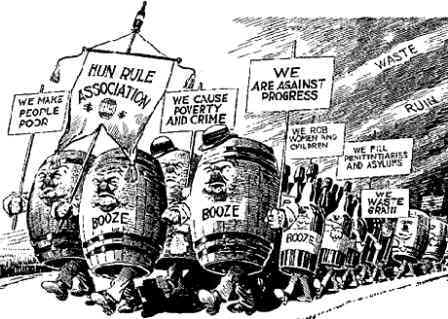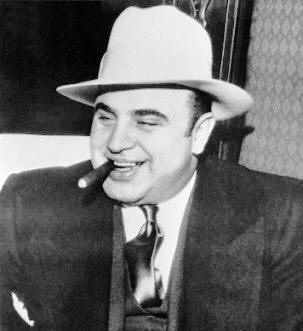|

|
Prohibition Cartoon
The Prohibition Cartoon illustrates the
reasons for support of the Prohibition movement as
making people poor, causing poverty and crime, the
impact of liquor consumption on women and children. The
reference to the Hun was promoting WW1 anti-German
sentiments
|
|
1920's Prohibition Era Facts for kids: Fast Fact Sheet
Fast, fun facts and Frequently Asked Questions (FAQ's)
about the
Prohibition Era and the ban on alcohol.
What was the Prohibition Era?
The Prohibition Era was a period in American
history when the manufacture and sale of
alcohol was banned (Drinking liquor was
never illegal).
What date was Prohibition Era?
The date of the
Prohibition Era years in the United States
was from 1920 to 1933.
What was the reason and cause of
Prohibition? There were several reasons
and causes for Prohibition including the
lobbying of the Anti-Saloon League and
temperance movements such as the Women's
Christian Temperance Union and the
Prohibition Party. Anti-liquor protests by
Protestant churches and to the war effort
during WW1.
Why did Prohibition Fail?
Prohibition failed because bootlegging
became widespread. Organized crime and
gangsters took control of the distribution
of alcohol and the 'Speakeasies' of the
Roaring Twenties.
1920's
Prohibition Era Facts for kids
The following fact
sheet contains interesting facts and information on
Prohibition Era Facts for kids.
Facts
about Prohibition Era Facts for kids
Prohibition Era Fact 1:
The move towards prohibition began
long before the 1920s with the emergence of temperance
movements and the Anti-Saloon League. WW1 helped the
Anti-Saloon League to win its fight to make the USA
'dry' and ban alcohol. Many American brewers were German
immigrants, so the Anti-SaloonAnti-Saloon League claimed
that people who drank beer were traitors to their
country.
Prohibition Era Fact
2: Most temperance groups received
support from Protestant evangelical churches and
hundreds of thousands of women including those who
supported women's suffrage. The temperance movement had
gained considerable support in rural areas by people who
feared the temptations found in the cities.
Prohibition Era Fact 3:
The ideals of the
Progressive Movement had
swept across America and some prominent progressives
believed alcohol was responsible for many problems in
American life such as poverty, crime, abuse towards
women and children and the rise of unsavory saloons with
their association with prostitution and gambling.
Prohibition Era Fact
4: The Anti-Saloon League, established
in 1893, strongly supported nationwide prohibition
during WW1, emphasizing the need to destroy the
political power of the German based brewing industry,
the corruption of the saloons, waste, poverty, ruin and
the need to reduce domestic violence.
Prohibition Era Fact
5: A famous temperance reformer was
Carrie Amelia Moore Nation (1846–1911) who carried out a
series of hatchet-swinging, saloon-smashing missions in
large cities across the country.
Prohibition Era Fact
6: Support also came from many
businesses who believed that the consumption of liquor
harmed the efficiency of their workers.
Prohibition Era Fact
7: Political reformers viewed the saloon
as the informal headquarters of the machine politics
that controlled voter loyalty by distributing political
and economic benefits such as jobs and city contracts
Prohibition Era Fact
8: A Prohibition movement emerged that began to
support the elimination of intoxicating liquor by constitutional
amendment. Votes were gained as Americans supported politicians who
were 'dry'
Prohibition Era Fact
9: With the
American Entry into WW1
in 1917, Congress prohibited the manufacture and
importation of distilled liquor in order to aid the war
effort and submitted it to the states for ratification.
Prohibition Era Fact
10: Prohibition was instituted with
ratification of the
18th Amendment to the United States Constitution on
January 16, 1919 that made it illegal to make, sell,
transport, import or export alcohol anywhere in the
United States.
Prohibition Era Fact
11: Prohibition came into force at
midnight on January 17, 1920 and the Volstead Act was
passed to enforce the amendment. Anti-Saloon League
attorney Wayne Wheeler drafted both the amendment and
the bill. Exceptions to the Eighteenth Amendment were
made for the manufacture and sale of alcohol for
medicinal and religious uses.
Prohibition Era Fact
12: The Volstead Act: Congress enacted
the Volstead Act, officially known as the National
Prohibition Act, to enforce the amendment, and became
effective on January 29, 1920. The Volstead Act defined
"intoxicating liquors" and provided penalties for abuse
of the law. Andrew J. Volstead, U.S. Representative from
Minnesota, sponsored the bill and lent his name to the
act.
Continued...
Facts
about Prohibition Era Facts for kids
Prohibition
Era Facts for kids
The following fact
sheet continues with Prohibition Era Facts for kids.
Facts
about Prohibition Era Facts for kids
Prohibition Era Fact 13:
The Prohibition Bureau was established but proved
to be an ineffective, undermanned and under-funded agency who
employed low paid agents to enforce the law.
Prohibition Era Fact 14:
Effects Of Prohibition: Drinking
liquor was never illegal and alcoholic drinks were still
widely available. The 18th Amendment and Volstead Act
put legal brewers out of business and the nation's door
became open to unintended consequences such as
bootlegging, speakeasies, gangsters, corruption and the
rise of organized crime. It also ushered in the era
known as
The Roaring Twenties when people wanted to
enjoy themselves and an enormous public demand for
illegal alcohol.
Prohibition Era Fact 15:
Bootlegging: The people who illegally
made, imported, or sold alcohol during this time were
called 'Bootleggers'. Bootleggers built secret breweries
to make liquor and counterfeited prescriptions and
liquor licenses to gain access to alcohol. Most of the
alcohol was smuggled into the USA from Canada, Mexico or
the West Indies.
Prohibition Era Fact 16:
Bootlegging: Bootlegging grew into a
vast illegal empire that was rife with bribery and
corruption. Prohibition Bureau agents, police, judges
and politicians, received monthly bribes and retainers
(up to $300,000 a month) to look the other way.
Prohibition Era Fact 17:
Bootlegging: The word 'Bootlegging'
was derived from the old trading practice of concealing
flasks of illegal liquor in boot tops when going to
trade with Native American Indians.
Prohibition Era Fact 18:
The Speakeasy: A Speakeasy was a
saloon or nightclub that sold alcoholic beverages
illegally. Saloons and Speakeasy clubs claimed to sell
soft drinks and coffee, but served alcohol behind the
scenes. Speakeasies (speak-easies) were so named because
patrons had to whisper code words to enter the illegal
drinking clubs
Prohibition Era Fact 19:
The Speakeasy: New York City had
nearly 100,000 speakeasy clubs. Chicago had more than
7,000 speakeasies and drinking parlors. Some Speakeasies
served food and had floor shows with live bands playing
1920s Jazz music and people danced the Charleston.
Prohibition Era Fact
20: Gangsters: Mobsters and the Mafia
limited their activities to prostitution, gambling, and
theft until 1920. Gangsters dominated various cities and
provided bootleg alcohol for speakeasies. Each major
city had its own gangster element.
Prohibition Era Fact
21: Gangsters: An estimated 1,300 gangs
operated in Chicago.
● There was an increase in
organized crime because of the massive profits to be
made in bootlegging and the speakeasies
● George Remus was known as the
"King of the Bootleggers" and made $40 million in
less than 3 years
● Charles “Lucky” Luciano
operated in New York and reputed to make $4 million
per year
● William McCoy was nicknamed
“the real McCoy,” because his liquor was never
diluted
● The most famous mobsters in
Chicago were Al "Scarface" Capone and his
Chicago Mafia who
fought rival gangs led by George “Bugs” Moran.
● Hostility between the two
gangsters led to the 1929 St. Valentine's Day
Massacre
● In 1930 FBI Agent Elliot Ness tackled
violators of prohibition and Al Capone's gang in
Chicago.

Prohibition Era Fact
22: It has been estimated that during the
Prohibition Era, $2,000 million worth of business was
transferred from the brewing industry and bars to
bootleggers and gangsters.
Prohibition Era Fact
23: Prohibition cost the federal
government a total of $11 billion in lost tax revenue
and cost over $300 million to enforce
Prohibition Era Fact
24: 3000 Americans died every year from
the effects of drinking tainted illegal liquor from the
black market
Prohibition Era Fact
25: Prohibition became increasingly
unpopular during the
Great Depression and a wealthy
Republican, Pauline Sabin, started a repeal movement
Prohibition Era Fact
26: Wickersham Commission: The Wickersham
Commission (1929-1931) was established by President
Herbert Hoover who appointed former U.S. Attorney
General George W. Wickersham to head the U.S. National
Commission on Law Observance and Enforcement. The
Wickersham Commission reported that Prohibition was not
working.
Prohibition Era Fact
27: Prohibition failed because:
● There were not enough
Prohibition agents to enforce the law and they were
easy to bribe
● The size of America's
boundaries made it hard for agents to control
smuggling by bootleggers
● The banning of alcohol had
led to the rise of powerful gangsters and organized
crime
● The American Public did not
support the law and were willing to drink in
speakeasies
● It became very difficult to
convict those who violated Prohibition because
public support for the law, and its enforcement,
dramatically decreased
Prohibition Era Fact
28:
The 18th amendment was repealed by the
21st Amendment
during the presidency of Franklin Roosevelt. The
twenty-first amendment was passed by Congress on
February 20, 1933 and ratified on December 5, 1933. The
popular vote for repeal of Prohibition was 74% in favor
and 26% in opposition. By its terms, states were allowed
to set their own laws for the control of alcohol.
Prohibition Era Fact
29: The Repeal of Prohibition
dramatically reduced organized crime and corruption.
Prohibition Era Fact 30:
After the repeal some states
continued Prohibition by maintaining statewide
temperance laws. Mississippi was the last 'dry' state
and ended Prohibition in 1966.
Prohibition Era Fact
31: At the end of Prohibition President
Franklin D. Roosevelt is quoted as saying "What America
needs now is a drink"
Facts
about Prohibition Era Facts for kids
Facts
about
Prohibition for kids
For visitors interested in the history of
Prohibition refer to the following articles:
Prohibition Era Facts for kids - President Woodrow Wilson Video
The article on
Prohibition Era Facts provides detailed facts and a summary of one of the important events during his presidential term in office. The following
Woodrow Wilson video will
give you additional important facts and dates about the political events experienced by the 28th American President whose presidency spanned from March 4, 1913 to March 4, 1921.
Prohibition Era Facts
●
Interesting Facts about Prohibition Era Facts for kids and schools
●
Key events
and Prohibition Era Facts for kids
●
The Prohibition Era Facts, a major
event in US history
●
Woodrow Wilson Presidency from March 4, 1913 to March 4, 1921
●
Fast, fun facts about Prohibition Era Facts
●
Foreign & Domestic
policies of President Woodrow Wilson
● Woodrow Wilson Presidency and
Prohibition Era Facts for schools,
homework, kids and children |